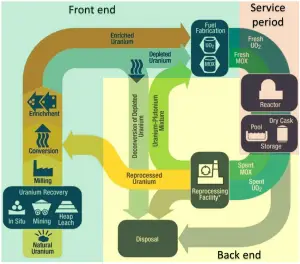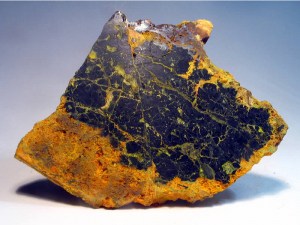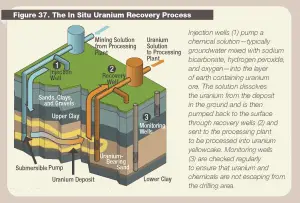
Uranium mining and milling is the starting process for all nuclear fuel cycles. In this process, uranium ore is extracted from the Earth’s crust, similarly to mining copper, zinc, and other metals. Uranium is often found with copper, phosphates, and other minerals; thus, it is often a co-product of other mining operations. The worldwide production of uranium in 2015 amounted to 60496 tonnes. Kazakhstan, Canada, and Australia are the top three producers and account for 70% of world uranium production.
Uranium is commonly found at low levels (a few ppm – parts per million) in all rocks, soil, water, plants, and animals (including humans). Uranium also occurs in seawater and can be recovered from ocean water. But only a few of the uranium ores known contain sufficient uranium (greater than 0.1%) to extract commercially. Significant concentrations of uranium occur in some substances such as uraninite (the most common uranium ore), phosphate rock deposits, and other minerals.

Natural uranium refers to uranium with the same isotopic ratio found in nature. It consists primarily of isotope 238U (99.28%). Therefore the atomic mass of the uranium element is close to the atomic mass of the 238U isotope (238.03u). Natural uranium also consists of two other isotopes: 235U (0.71%) and 234U (0.0054%). The abundance of isotopes in nature is caused by differences in the half-lives. All three naturally-occurring isotopes of uranium (238U, 235U, and 234U) are unstable. On the other hand, these isotopes (except 234U) belong to primordial nuclides because their half-life is comparable to the age of the Earth (~4.5×109years for 238U).
In-situ Leaching – In-situ Recovery
As with other types of hard rock mining, there are several extraction methods. In the case of uranium mining, it strongly depends on the concentration of uranium in the ore. For example, the ore extracted from the Australian Olympic Dam Mine has a concentration of 0.05 %, and most reserves have uranium with a concentration of between 0.1 bis 0.2 %. In Canadian Saskatchewan, the ore mined contains more than 20 % uranium.

In-situ leaching (ISL), also known as in-situ recovery, is a mining process different from the conventional method in that it uses a chemical process to separate the uranium in the Earth’s crust from the surrounding rock. In-situ is a Latin phrase that translates to “on site” or “in position.” In-situ leach for uranium has expanded rapidly since the 1990s and is now the predominant method for mining uranium. In this technology, uranium is leached from the in-place ore through an array of regularly spaced wells and is then recovered from the leach solution at a surface plant. The chemical solution is injected into a drilled hole into the rock at the periphery of the uranium deposit. Solutions to dissolve uranium ore are either acid (sulfuric acid or, less commonly, nitric acid) or carbonate (sodium bicarbonate). This liquid loosens the uranium from the rock and binds it; in other words, it is “flushed “out of the rock. Now supplemented with uranium, this solution is brought up to the surface through another borehole. The extracted uranium solution is then filtered through resin beads. The resin beads attract uranium from the solution through an ion exchange process. Uranium-loaded resins are then transported to a processing plant, where U3O8 is separated from the resin beads, and a yellowcake is produced. The ISL method can be used without enormous mining quantities of rock. There are no tailings or waste rock generated. It also impacts the environment and health less than the conventional method, and it is cheaper. On the other hand, there are potential hazards of groundwater contamination. Not all of the contaminated liquid is pumped out. The rock reacts to the chemical solution unpredictably. Therefore, the ISL method can only be performed under certain subsurface conditions. In 2012, the percentage of the mined uranium produced by in-situ leach was 44.9 percent. In this technology, uranium is leached from the in-place ore through an array of regularly spaced wells and is then recovered from the leach solution at a surface plant. For example, the Honeymoon Mine was Australia’s second operating in-situ recovery uranium mine, beginning production in 2011.